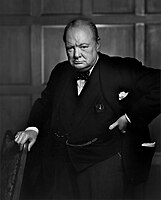
Back Übergangsregierung Churchill German Gouvernement Churchill II French Kabinet-Churchill II Dutch Drugi rząd Winstona Churchilla Polish Geçici Churchill Hükûmeti Turkish
Churchill caretaker ministry | |
|---|---|
| May–July 1945 | |
 Churchill, The Roaring Lion, 1941 | |
| Date formed | 23 May 1945 |
| Date dissolved | 26 July 1945 |
| People and organisations | |
| Monarch | George VI |
| Prime Minister | Winston Churchill |
| Prime Minister's history | 1940–1945 |
| Deputy Prime Minister | None appointed[a] |
| Total no. of members | 92 appointments |
| Member parties | |
| Status in legislature | Majority (coalition) 420 / 615 (68%)
|
| Opposition party | Labour Party |
| Opposition leader | Clement Attlee |
| History | |
| Outgoing election | 1945 general election |
| Legislature term | 1935–1945 |
| Predecessor | Churchill war ministry |
| Successor | First Attlee ministry |
The Churchill caretaker ministry was a short-term British government in the latter stages of the Second World War, from 23 May to 26 July 1945. The prime minister was Winston Churchill, leader of the Conservative Party. This government succeeded the national coalition which he had formed after he was first appointed prime minister on 10 May 1940. The coalition had comprised leading members of the Conservative, Labour and Liberal parties and it was terminated soon after the defeat of Nazi Germany because the parties could not agree on whether it should continue until after the defeat of Japan.
The caretaker government continued to fight the war against Japan in the Far East but Churchill's focus was on preparation for the Potsdam Conference where he, accompanied by Clement Attlee and Anthony Eden, would meet Joseph Stalin and Harry Truman. The main concern on the home front, however, was post-war recovery including the need for reform in key areas such as education, health, housing, industry and social welfare. Campaigning mostly on those issues, the parties canvassed for support in the forthcoming general election, the first held in the UK since 1935. The general election was held on 5 July but, allowing time to collect the large numbers of votes by overseas service personnel, the result was not announced until 26 July and was a landslide victory for Labour. Churchill thereupon resigned as prime minister and was succeeded by his erstwhile coalition deputy Attlee, who formed a Labour government.
Cite error: There are <ref group=lower-alpha> tags or {{efn}} templates on this page, but the references will not show without a {{reflist|group=lower-alpha}} template or {{notelist}} template (see the help page).